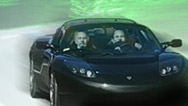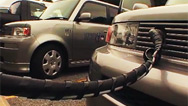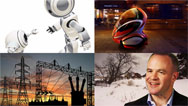Wireless Electricity?
- By David Levin
- Posted 05.19.11
- NOVA
WiTricity, a small startup based outside of Boston, is developing a system that can transmit electricity wirelessly. The company hopes the system will make charging electric cars easy, eliminating the need for bulky cables. What impact might this have on the electric vehicle market?
 Listen
Listen
Using a new wireless charging system, plug-in electric cars may be able to shed their power cables entirely.
Transcript
Wireless Electricity?
Posted: May 19, 2011
DAVID LEVIN: You're listening to a NOVA Podcast. I'm David Levin.
Over the last few years, electric cars have gone from a fringe idea to the mainstream. Ford, Nissan, GM, Chevy, Toyota, and Honda all have new electric models coming out. But there are still some hurdles to overcome before fully electric cars will start selling big. For starters, there's that power cable...
ERIC GILER: The cable that you use, while it's very capable, it's big—it looks as big as a gas pump. Some people may not be able to deal with it.
DAVID LEVIN: Eric Giler is CEO of WiTricity, a small startup outside of Boston. He thinks that one way to make electric cars more attractive to consumers is to bypass power cables entirely.
ERIC GILER: Most of the major auto manufacturers around the world have already figured out that there will not be widespread adoption of electric vehicles if you have to plug them in. And so this is where wireless electricity will be quite helpful, we believe, in the long term, to increasing adoption of electric vehicles.
DAVID LEVIN: That's right: wireless electricity. In Giler's view, you should be able to charge your car without actually connecting it to anything.
ERIC GILER: So you drive home, you walk away from your car, and it just charges. You pull into a parking garage: "Electric vehicles, park here," you park there and walk away, knowing that your car will be charged.
DAVID LEVIN: His company is developing a system that can actually do that. It takes advantage of the fact that electricity and magnetism are related. It's pretty easy to turn one into the other. Run electric current through a coil of wire, and it'll make a magnetic field. Put a second coil of wire in that field, and it'll create electricity.
But there's a catch. If you're using a plain old magnetic field to do this, the coils need to be really close to each other—fractions of an inch. If you pull them apart, it'll stop working.
With WiTricity's system, you can separate the coils by several feet. That's because they only respond to a specific kind of magnetic field, one that operates at a high frequency.
ERIC GILER: So imagine you take electricity, you turn it into a magnetic field, you get another object that can—and I'll put that in quotes—"recognize" the magnetic field, and only that magnetic field. The frequency has to be tuned exactly. You want it to be a relatively high frequency, typically at around 150 kilohertz. That means 150,000 cycles per second.
DAVID LEVIN: Because it's tuned to a specific frequency, the field doesn't have to be very strong. Giler says that nothing else in the room—people, furniture, even pieces of metal—will react to it. He's hoping that the system will attract auto companies.
ERIC GILER: So let me just show you back here. Back here's where we build a lot of the stuff...
DAVID LEVIN: Behind a back door in WiTricity's office is a brightly lit garage. It's full of workbenches and testing equipment. In one corner, there's a brand new electric Smart car, a tiny little two-seater the size of a golf cart. With a simple modification, Giler says it'd be easy to charge it wirelessly. All it would take is two of those coils I mentioned.
ERIC GILER: The coil itself that's inside here is about 16 inches by 16 inches. The package is a little bit bigger. It's a little beefier just so that, in case you run over it or something, or gets hit with rocks from the road or something.
DAVID LEVIN: Now, it's not very thick...
ERIC GILER: No. It's 3.75 centimeters. These things are typically designed to weigh a little under 10 pounds. And then the charging device is this right here, which is what, maybe a foot by 8 inches, so it's just a block that hangs on the wall.
DAVID LEVIN: If you own a garage, this might be a convenient way to power an electric car. Unfortunately, it won't charge it any faster than just plugging it in. And it still doesn't address a bigger problem. Once you leave the house, there are very few places where you can recharge. So if your battery runs low on the road, you could be out of luck.
KIM REYNOLDS: Our country is not really ready for—particularly the middle of the country—is not really ready for this stuff. So that can be a real challenge.
DAVID LEVIN: Kim Reynolds works for Motor Trend magazine. He drove a plug-in electric car from Detroit to southern California. He says that outside of major cities, it's pretty hard to find places to charge.
KIM REYNOLDS: The infrastructure is just nonexistent. You literally have to do it yourself. I mean, I was driving out with an extension cord, and going though parking lots trying to find plugs, and figuring out "if I park it here, you know, will that reach?" And that's kind of entertaining to a person like me, but that's not a real solution for actual human beings.
ERIC GILER: Oh, I think the infrastructure will need to be in place to have widespread adoption of electric vehicles as well—whether it's plug or plugless.
DAVID LEVIN: Even Giler admits that this is a sort of chicken-or-egg situation. Without more charging stations by the roadside, it could be tough to convince consumers to buy electric cars. But he's still optimistic that sales will pick up in the future. And if that happens, he's betting that wireless charging will be a popular feature.
ERIC GILER: Maybe every car just comes wireless-capable. You know, you buy a computer now. You used to buy a laptop a few years ago, if you wanted it to be wireless, you'd have to buy an option. Now, I think you probably couldn't buy a laptop that wasn't wireless-capable. So imagine it's the same thing for power, because it really is the last thing to go wireless.
Credits
Audio
- Produced by
- David Levin
Image
- Car with wireless electric device
- © WiTricity Corporation
Related Links
-

Car of the Future
Join the "Car Talk" guys as they hit the road in search of a new breed of clean, fuel-efficient vehicles.
-

Cars That Power the Grid
Electric cars that feed energy back to the power grid may play a critical role in a future "smart grid."
-

What's the Next Big Thing?
Greet the future: social robots, a "smart" electric grid, microbes that make diesel fuel, and more.
You need the Flash Player plug-in to view this content.

